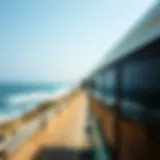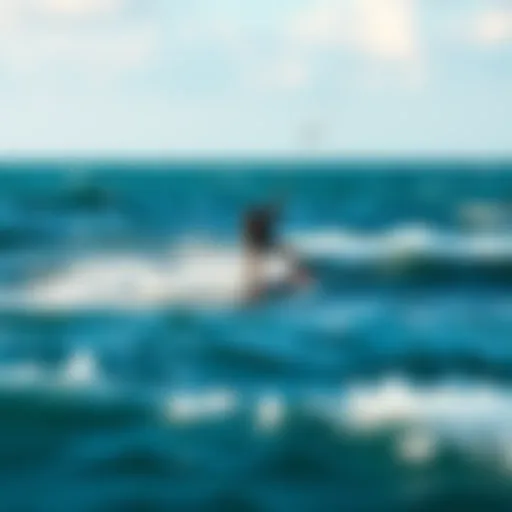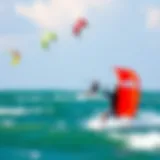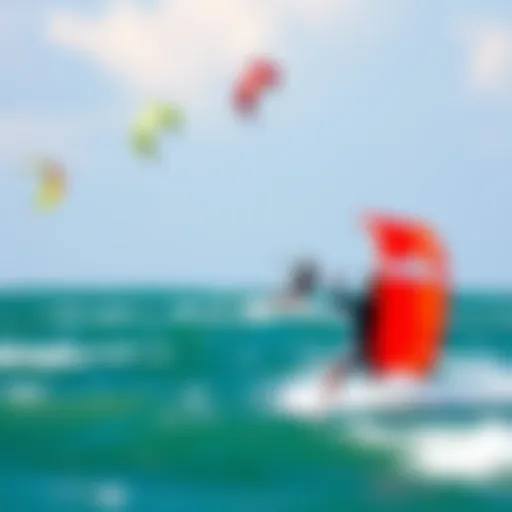Exploring the Unique Weather of Panama City Beach


Intro
Navigating the weather landscape of Panama City Beach is more than just glancing at a weather app; it’s about understanding the unique patterns that dictate conditions from season to season. For kiteboarding enthusiasts, knowing whether the wind is going to cooperate can make the difference between a day of thrill on the water and a dreary time stuck on the shore.
This coastal paradise offers a playground where sun, sea, and wind collide, creating the perfect backdrop for kiteboarding. From analyzing seasonal changes to recognizing wind patterns, it’s crucial for both novice and experienced kiteboarders to be in the know. Understanding how local weather conditions influence kiteboarding can lead to better planning and ultimately enhance the overall experience.
In the sections that follow, we will delve into essential techniques and equipment that can elevate your kiteboarding skills while maximizing your enjoyment based on the weather forecasts. Let’s take a deep dive into the nuances of Panama City Beach's local weather and how it intertwines with the thrilling world of kiteboarding.
Intro to Panama City Beach Weather
When it comes to enjoying all that Panama City Beach has to offer, understanding the local weather is crucial. This tropical location is not just about beautiful beaches and vibrant sunsets; the dynamic climate here plays a significant role in shaping outdoor experiences, especially for kiteboarders and other water sports enthusiasts. Knowing the ins and outs of weather conditions allows individuals to make informed decisions about their activities, ensuring both safety and enjoyment on the water.
Geographical Influence
Panama City Beach lies along the Gulf of Mexico, which has a profound impact on its weather patterns. The warm waters of the Gulf not only influence temperature but also affect humidity levels throughout the year. Nestled between towering dunes and picturesque coastal landscapes, this stunning destination enjoys a subtropical climate, characterized by hot summers and mild winters. The unique positioning also brings the occasional sea breeze, which can provide much-needed relief from the heat, especially during the peak of summer.
Moreover, the surrounding geography makes it susceptible to various weather systems. For instance, during late summer, the region can be influenced by tropical storms and hurricanes. Understanding these geographical nuances is essential for anyone planning to visit or engage in outdoor activities. Being aware of how nearby water bodies and landscapes interact with weather can help kiteboarders select the best spots for both training and recreational outings.
Climatic Overview
The climatic conditions of Panama City Beach can be understood through a detailed examination of its annual weather trends. Generally, the area experiences a humid subtropical climate that contributes to discrete seasons, which especially interest outdoor lovers.
- Spring: This season typically ushers in warm temperatures and blooming flora, making it a favorite time for kiteboarding enthusiasts. Average highs reach into the 70s and low 80s Fahrenheit, accompanied by moderate winds that create favorable conditions for new and seasoned riders alike.
- Summer: Expect hot, humid days where temperatures can soar into the 90s. This is also the prime time for tourists to flock to the beach. Wind patterns can be unpredictable, so kiteboarders should prepare for both calm days and those with a healthy breeze. Remember that afternoon thunderstorms can also pop up unexpectedly, affecting plans late in the day.
- Fall: As summer fades, the weather begins to transition, providing mild temperatures perfect for outdoor pursuits. Cooler evenings arrive, and the winds start to shift, offering a different vibe for kiteboarding.
- Winter: Generally mild, winters can surprise visitors with cooler spells that dip into the 40s and 50s. Kiteboarding becomes less common during this season, but it offers a unique backdrop for those willing to brave the elements.
Understanding these climatic conditions can help in scheduling activities. For kiteboarders, having a sense of when to expect consistent winds and manageable temperatures can make or break an outing. The balance between warm weather, proper wind speeds, and the absence of severe storms not only ensures a better experience but can also mitigate risks associated with sudden weather changes.
"The wind patterns and seasonal shifts in Panama City Beach create a unique playground for kiteboarders looking to make the most of their time on the water."
Seasonal Weather Trends
Understanding the seasonal weather trends of Panama City Beach is essential for anyone aspiring to enjoy kiteboarding or any other outdoor activity. The unique climate here can make or break a day on the water. By being aware of the seasonal nuances, kiteboarders can tailor their plans to maximize their time riding the waves under optimal conditions.
Spring Conditions
As spring rolls in, Panama City Beach begins to shed the chill of winter. Typically, temperatures range from the mid-60s to the mid-80s Fahrenheit. The winds become increasingly favorable for kiteboarding during this time. Southeast breezes create water conditions that are hard to resist.
Popularity picks up in spring as both locals and tourists flock to the shore. However, early spring can still be a gamble; some days are remarkably still. It's essential to check local forecasts frequently through resources like weather.gov to understand the shifts in wind patterns and avoid frustration.
Tip for kiteboarders: Keep an eye out for coastal breezes and plan your sessions for midday when the winds are more reliably consistent.
Summer Heat and Humidity
Come summer, heat and humidity become the name of the game. Temperatures often hit the high 80s and low 90s. While hot days might seem like perfect kiteboarding weather, the humidity can make it feel significantly warmer. It's crucial to stay hydrated and take breaks to avoid exhaustion.
Winds can be less predictable during summer months, often accompanied by scattered thunderstorms in the afternoons. The summertime also brings more windless spells, so keeping a flexible schedule can help you seize the good conditions when they arise. Look at local forums on Facebook for real-time updates from the kiteboarding community who often share their experiences and advice.
Fall Transition
As we transition into fall, there's a noticeable shift in both temperature and wind. The heat of summer starts to dissipate, leaving behind milder weather. Temperatures generally range from the mid-70s to low 80s. Fall offers some of the best conditions for kiteboarding, thanks to steady winds and fewer rainy days. This is a time when both amateur and seasoned kiteboarders can enjoy smooth rides and long sessions.
Part of this seasonal magic is also the drop-off in crowds, making it a more relaxing experience on the water. Plan to catch the traditional trade winds that begin to pick up, prefer the afternoons when conditions are often optimal for a great kiteboarding experience.
Winter Weather Patterns


Winter in Panama City Beach presents unique weather challenges. The temperatures take a dive, often ranging from the mid-50s to mid-60s. While many kiteboarders might think this signals the end of their outdoor days, it’s essential to remember that winter can also bring some surprisingly good conditions.
The wind becomes more consistent and powerful, which many experienced kiteboarders find exhilarating. However, the air temperatures can feel crisp, which leads to the necessity for proper gear. Investing in a quality wetsuit becomes crucial during this time.
Winter is also a much quieter season, and interactions with local kiteboarders can provide invaluable insights into the best spots and times to head out.
Wind Patterns and Their Importance
Understanding the wind patterns around Panama City Beach is crucial for anyone looking to embrace outdoor sports like kiteboarding. The winds carry not just refreshing breezes but also play a vital role in both the safety and enjoyment of water activities. Being aware of how winds behave at different times of year can help kiteboarders pick the best days for gliding across the waves. This section digs into prevailing wind directions and how these factors come together to create the ideal conditions.
Prevailing Wind Directions
Panama City Beach experiences a mix of wind directions throughout the year. Generally, the most common wind originates from the east-southeast. This direction tends to provide consistent conditions that kiteboarders appreciate.
Here’s a breakdown of notable wind patterns:
- Spring: The winds shift more southeast to south, giving way to gentle breezes that are excellent for beginners or those looking for a leisurely kiteboarding experience.
- Summer: It’s not uncommon to see stronger winds from the south and southwest, particularly in the afternoons. These winds can lead to exciting, challenging conditions for more experienced kiteboarders.
- Fall: As temperatures cool, winds can shift again towards northeast. This time of year often brings calmer weather, creating a good opportunity for relaxed outings on the water.
- Winter: Although less predictable, winter winds are usually from the north, bringing cooler air. While kiteboarding may still be an option, riders should prepare for variable conditions.
Understanding these patterns can save kiteboarders a world of trouble. It affects not only their surfing experience but also their safety.
Impact of Winds on Kiteboarding
The winds directly influence kiteboarding performance. They determine how high one can fly, the speed of travel, and the overall control in the air.
- Lift and Control: Stronger winds definitely give more lift. This can be exhilarating, but it also requires skill to manage your kite effectively. When conditions are too windy, even seasoned kiteboarders might find themselves struggling.
- Choosing Kites: Depending on the wind speeds, kiteboarders need to select the right size of kite. Larger kites are typically used in lower winds, while smaller ones are better suited for high winds. That makes knowing the wind forecast a game-changer.
- Directional Changes: Winds affect not just speed but also the directional control. If a wind suddenly shifts, it has the potential to take a rider off course or create hazardous conditions. Awareness of wind changes is crucial.
In short, the winds around Panama City Beach are more than just an elemental factor; they shape the very experience of kiteboarding.
Understanding wind patterns adds another layer to the art of kiteboarding—it's not just about riding the waves, but mastering the air and enjoying the journey.
For those keen on making the most out of their kiteboarding adventures in Panama City Beach, staying tuned into wind conditions through local reports or tools like Windy.com can provide invaluable insights.
Rainfall and Storm Patterns
Understanding rainfall and storm patterns is crucial for anyone engaging in outdoor activities in Panama City Beach, especially kiteboarders. The unique weather this coastal area experiences can dramatically influence both the safety and enjoyment of water sports. With varying rainfall, gusty storms, and occasional hurricanes, knowledge in this area allows enthusiasts to prepare adequately, ensuring that they can safely ride the waves and make the most of their time on the water.
Annual Rainfall Statistics
Panama City Beach is no stranger to tropical climates, leading to fairly substantial rainfall year-round. On average, the area receives about 60 inches of rain per year. The heaviest precipitation often occurs in the summer months, particularly between June and September.
- Monthly Breakdown:
- June: A significant increase in rainfall begins, with averages around 6 inches.
- July and August: These months can see upwards of 8 inches, often accompanied by sudden thunderstorms.
- September: While still part of summer, it marks a transition into the fall with slightly lower averages but remains prone to hurricane activity.
Understanding these statistics can assist kiteboarders in planning their outings. Rain does not inherently mean that conditions are unfavorable, as brief showers can clear quickly, making way for wind and sun conducive to water sports.
Hurricane Season Considerations
Hurricane season can be a double-edged sword for those who love kiteboarding in Panama City Beach. Lasting from June 1 to November 30, this period demands attention to local weather updates and caution for safety reasons.
Key points to consider include:
- Preparedness: Always keep an eye on local forecasts, especially during peak hurricane months of August and September.
- Evacuation Plans: If forecasts predict a storm, being aware of evacuation routes and local resources is important.
"The calm before the storm can give way to conditions that change in a heartbeat; always stay informed."


While many kiteboarders relish the wind generated by storms, it is important to recognize the dangers involved. Winds can become unpredictable, and safety should always be paramount. Having a thorough understanding of how to respond to changes in weather will allow enthusiasts to enjoy Panama City Beach's waters more fully while minimizing risks associated with rainfall and storms.
Climate Change Impacts
Climate change has emerged as a critical factor influencing weather patterns globally, and its impacts are clearly felt in places like Panama City Beach. Understanding how these changes manifest locally is essential for anyone who enjoys outdoor activities, particularly kiteboarding. By recognizing climate change effects, enthusiasts can make informed decisions, ensuring safety and enjoyment while engaging with this exhilarating sport.
Importance of Recognizing Climate Change: The increasing unpredictability of weather can be attributed in part to climate change. With sea levels rising and extreme weather events becoming more common, kiteboarders must be aware of these shifts. It’s not just about how sunny it might be on a given day, but also about understanding the broader trends that might influence wind and wave conditions at different times of the year.
Long-term Weather Variation
Long-term weather variation refers to the consistent shifts in climate patterns over extended periods. Panama City Beach is experiencing subtle yet undeniable transformations that could change the local kiteboarding environment.
- Temperature Changes: Average sea and air temperatures in Panama City Beach have been gradually increasing. Warmer waters influence local weather systems, stirring up more intense storms and altering wind patterns.
- Precipitation Trends: Rainfall amounts can vary significantly as well. Some years witness flash flooding due to heavier downpours, affecting not just kiteboarding schedules but overall beach activities.
- Habitats and Ecosystems: Changes in climate also impact the surrounding ecosystems. Species migratory habits may shift, affecting the natural beauty that kiteboarders appreciate while out on the water.
"Awareness is the first step towards adaptation. Kiteboarders must pay attention to evolving local conditions, which reflect global changes."
Predicted Changes in Local Climate
As the climate continues to evolve, specific predictions can be made about how the weather in Panama City Beach will likely change over the upcoming years. These predictions will guide kiteboarding enthusiasts in planning their activities more effectively.
- Increased Storm Frequency: Experts anticipate that tropical storms and hurricanes may become more frequent. Understanding the hurricane season's nuances becomes paramount for safety.
- Changing Winds: Typically, winds in Panama City Beach are favorable for kiteboarding. However, adjustments in prevailing patterns could alter conditions that are currently ideal. Observing these winds and adapting to new patterns is crucial for successful kiteboarding.
- Longer Warm Seasons: A potential elongation of the warm season may lead to extended kiteboarding opportunities, but it also raises concerns about managing heat stress and sun exposure. Staying hydrated and protected from the sun is critical.
Engaging with these predictions can arm kiteboarders and instructors with the knowledge they need. By staying informed and adjusting practices accordingly, they can mitigate negative impacts of climate change on their beloved sport.
Weather Forecasting Techniques
When it comes to experiencing the thrill of kiteboarding on the pristine waters of Panama City Beach, understanding the local weather forecasting techniques is of paramount importance. The ability to accurately predict weather patterns directly impacts both safety and enjoyment for enthusiasts and instructors alike. With varying wind strengths, humidity levels, and potential storms, knowing how to access and interpret these forecasts can make the difference between a great day on the water and one spent indoors.
Using Technology for Accuracy
In today's digital age, technology plays a significant role in staying informed about weather conditions. Various tools and platforms provide real-time data that helps kiteboarders plan their outings. Here are some of the most effective technologies available:
- Weather Apps: Mobile applications like Windy and NOAA Weather Radar allow users to access localized forecasts, including wind speed and direction.
- Local Weather Stations: Many regions have dedicated meteorological stations that provide precise information for microclimates. Websites such as weather.gov offer detailed updates relevant to Panama City Beach.
- Social Media Updates: Following local kiteboarding clubs or weather-related feeds on platforms like Facebook or Reddit can provide insight into immediate conditions shared by fellow enthusiasts.
Using these resources, kiteboarders can gain a clearer picture of what to expect. Proper use of technology ensures that you’re not just relying on vague forecasts, but have actionable data in hand.
Local Forecasting Resources
Beyond technology, local knowledge is invaluable. Resources within Panama City Beach allow kiteboarders to stay connected to the area's weather patterns. Consider the following:
- Local Kiteboarding Shops: Shops often have staff who are experienced and informed about current conditions. They can share insights on recent weather and provide opinions on the best times to kiteboard.
- Community Events and Gatherings: Engaging with local events can yield useful information. Connecting with other kiteboarders develops a network that shares their own experiences and predictions.
- Coastal Weather Networks: Organizations like the National Weather Service provide updates tailored to specific coastal needs. Their data can be instrumental in preparing for the uniquely changing conditions of this beach.
"The best forecast comes not just from technology, but from connecting with the local kitesurfing community. Your next perfect day on the water could be just a conversation away!"
Through these local forecasting resources, one can complement the high-tech solutions available, creating a broad understanding of Panama City Beach’s ever-changing weather. This synergy equips kiteboarders with a comprehensive set of tools to optimize their experience on the water, leaving no room for surprises.
Practical Tips for Kiteboarding
Kiteboarding in Panama City Beach can be a thrilling experience, but it requires skillful planning and an understanding of local weather conditions. Kiteboarders benefit greatly from awareness of winds, tide patterns, and seasonal shifts. With the right knowledge, you can ensure that your time on the water is not only enjoyable but also safe and as productive as it can be.
Beyond equipment, knowing the optimal times and conditions for kiteboarding directly influences your experience. This section will delve into practical considerations for making the most of your kiteboarding adventures.
Choosing the Right Time
Timing is key in kiteboarding. The difference between a pleasant ride and a frustrating outing often boils down to wind patterns and weather forecasts. In Panama City Beach, the best time to kiteboard is typically during late spring to early fall. During these months, prevailing winds tend to be more consistent.


Here are some factors to consider when picking the right time:
- Weather Patterns: Late morning to early afternoon is generally the sweet spot, as winds are more predictable and stronger.
- Seasonal Variations: Spring sees lighter winds ideal for beginners, while summer presents robust conditions suitable for seasoned kiteboarders looking to catch some thrills.
- Local Knowledge: Engaging with local kiteboarders can provide timely insights on daily conditions that forecasts might not capture.
Generally, it’s a good idea to keep an eagle eye on real-time weather apps that provide updates on wind direction, speed, and any impending weather systems. Apps like Windy can be incredibly helpful, giving you the quick scoop.
Gear Recommendations Based on Weather
The right gear can significantly enhance your time on the water. Weather elements like temperature and wind conditions should dictate your choice of equipment. Here's what to keep in mind:
- Bar and Lines: A shorter line setup may be beneficial in gusty wind conditions, giving you more control and easier handling.
- Kite Size: For lighter winds, you’ll want a larger kite to catch more air, while smaller kites are best for windy conditions to avoid being overpowered.
- Board Type: If you’re heading out in choppy waters, consider a board with a little more rocker to handle the rough seas effectively.
"The right kite for the conditions can make or break your experience. Don't skimp on equipment; it's an investment in your kiteboarding passion."
- Drysuits or Rash Guards: Depending on the season, you'll need to keep comfort in mind. During cooler months, a drysuit is essential, while rash guards can be perfect for shielding against sun and potential scrapes in warmer conditions.
Additional Tips:
- Maintain your gear regularly to ensure peak performance.
- Experiment with different setups in various conditions to learn what works best for you.
- Keeping a kiteboarding journal can help track what conditions suit your style, making future planning easier.
Kiteboarding in Panama City Beach can be as fulfilling as it gets. A careful selection of timing, gear, and local insights can turn a good day into an incredible one. Make it a point to stay informed and connected with the community, and your kiteboarding adventures will flourish.
The Role of Local Knowledge
Understanding the nuances of Panama City Beach's weather cannot be done in isolation. Local knowledge is an invaluable asset for kiteboarders and water sports enthusiasts alike. When navigating the ever-changing conditions of the beach, tapping into the expertise of those who have spent countless hours on the water can drastically improve one’s experience.
Connecting with Local Kiteboarders
The local kiteboarding community can provide insights that no weather app or online forecast can match. Many experienced riders know the intricacies of weather patterns that may not be immediately evident to newcomers.
Here are a few ways to benefit from their experience:
- Ask Questions: Never underestimate the power of a conversation. Local kiteboarders are usually more than happy to share their tips and tricks. Whether it’s the best spots to catch the wind or the ideal times to avoid turbulent conditions, their first-hand accounts will enrich your understanding.
- Social Media Groups: Platforms like Facebook or Reddit can be treasure troves for connecting with local enthusiasts. Search for groups dedicated to kiteboarding in Panama City Beach. Engaging with these communities will keep you informed about upcoming events, shared experiences, and real-time updates on the weather.
- Local Shops: Kiteboarding shops are not just places to purchase gear; they often serve as community hubs. The staff, frequently seasoned kiteboarders themselves, can provide invaluable insights tailored to specific conditions. They know the local winds inside and out and may even offer demos or classes, giving you firsthand experience.
Participating in Local Events
Joining local kiteboarding events can be another great avenue to harness local knowledge. These gatherings, whether they’re competitions, meet-ups, or casual rides, present a unique opportunity to observe skilled riders in action.
- Events and Competitions: Local competitions aren’t only for seasoned veterans. They often cater to various skill levels, and participating can expose you to advanced techniques and tactics. Additionally, networking with participants can broaden your resource pool.
- Workshops and Clinics: These events often feature expert instructors who share their techniques and weather insights. The dual focus on skill and local knowledge creates a rich learning environment.
- Community Rallies: Participating in local rallies or beach clean-up days not only gives back to the environment but also helps you connect with fellow kiteboarders. This camaraderie creates a support system where you can learn from one another.
Local knowledge is not just a luxury; it’s a necessity for anyone looking to make the most of their time on the water in Panama City Beach.
In the end, the key takeaway is the value of establishing connections within the kiteboarding community. Through these relationships, you gain not only insights into the local weather but also a sense of belonging and support that can enhance your overall kiteboarding experience.
Finale
The weather in Panama City Beach is not just a topic for small talk; for kiteboarding enthusiasts, it is essential to understand how local conditions can make or break a session on the water. This article has peeled back the layers of what makes the climate here unique, offering valuable insights that go beyond the surface. It’s about recognizing the rhythms of nature and how they align with the best opportunities for adventure.
In essence, the discussion covers various facets—from seasonal weather trends and wind patterns to local knowledge that connects kiteboarders with the community. Each of these elements is interwoven with the understanding that being aware of the local climate can dramatically improve one’s experience.
- Seasonal insights were provided, detailing what kiteboarders might expect throughout the year.
- Wind patterns were explored, demonstrating their significance in kiteboarding performance.
- The importance of local expertise was highlighted, as engaging with residents could lead to discovering hidden gems on the water.
By grasping the intricate weather tapestry of Panama City Beach, kiteboarding enthusiasts can approach their activity more strategically. It’s not merely about getting out there; it’s about maximizing every breeze and every wave.
"Understanding the local climate isn’t just a benefit; it's a necessity for any kiteboarder looking to catch the perfect wind."
Summary of Key Points
- Geographical Influence: Panama City Beach’s coastal location plays a pivotal role in its weather patterns, affecting seasonal temperature and wind.
- Seasonal Trends: Each season offers unique kiteboarding conditions; knowledgeable assessment can lead to incredible experiences.
- Wind Patterns: Understanding prevailing wind directions is crucial for kiteboarding; it enhances skill and enjoyment on the water.
- Rainfall and Storms: Awareness of the hurricane season is vital for safety and planning.
- Climate Change: Long-term shifts in weather patterns may impact kiteboarding, requiring adaptation from the sport's enthusiasts.
- Local Knowledge: Building connections with local kiteboarders enriches the experience, providing tips and fostering community.
Final Thoughts on Weather and Kiteboarding
Kiteboarding is a dance with the elements; therefore, having a solid grasp on local weather can mean the difference between a glorious day on the water and a disappointing outing. Understanding how Panama City Beach's weather interacts with your kiteboarding plans is not just helpful but critical. As this article illustrates, the beauty of this coastal paradise can be fully appreciated with the right insights.
Whether you’re a novice or a seasoned rider, the local weather is a language that, once learned, opens doors to infinite average moments transformed into unforgettable experiences.















